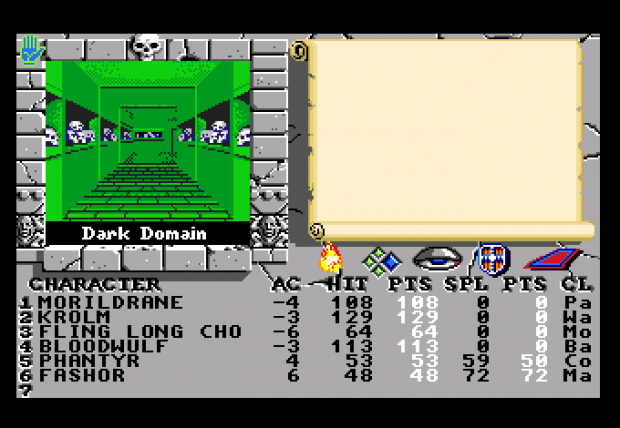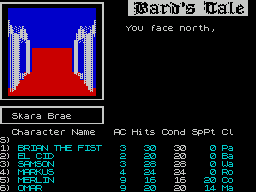First, sorry for not writing here for a long time. Some big career changes happened (whether good or bad, the jury is still out, but I’m mostly optimistic), and I haven’t had quite a lot of free time, though I hope that’ll improve in the future. With that out of the way…

… here is what I’ve been doing with some of what little free time I have: playing an 80s game I never actually played back then. The game is The Bard’s Tale II : The Destiny Knight (whew!), which I’m playing using an Amiga emulator. This is not actually the very best version, a title which belongs to the Apple IIGS port, but as I plan to move my party to Bard’s Tale III after I beat this game, and there’s no III port for the IIGS, I had to pick the (arguably) second best version.
As I said, I never actually played BT2 back in the 80s. Though I did play, and love, the first Bard’s Tale, first on the ZX Spectrum (on cassette!), then on the PC. As you can see, it looks mostly the same:

Anyway, I missed games like this. It’s really hard, with no hand holding, and grinding is a big part of the game. I actually like the fact that you can, at the very beginning of the game, go to dungeons or other places where the very first encounter will kill you (Bethesda, take note: scaling enemies to the player’s level sucks). And the dungeons seem designed by a sadist: lots of non-euclidean mazes (think going a step north and then a step south necessarily leaves you where you started? think again), permanent darkness zones, anti-magic zones, teleporters, spinners (they turn you around, which can be very confusing if you don’t have a magic compass, or even if you simply fail to notice it). Did I mention that there’s also no such thing as auto-mapping?
Anyway, I’m enjoying the game a lot. Yes, the graphics and sound are primitive, even for its time, and the game is little more than a grind-fest full of random encounters and dungeons that seem designed just to make your life miserable. On the other hand, there’s a strange pleasure in seeing your characters, which you nurtured since they were level 1 newbies, get stronger and stronger, and be able to face ever tougher challenges. Also, since it’s turn-based, and playable in an emulator window, it’s perfect for playing everywhere, at any time.
Tip 1: all of the Bard’s Tale versions are available for download at BardsTale.de. I recommend either the Commodore 64 or Amiga versions (or, if you don’t care about exporting your party to Bard’s Tale III, the Apple IIGS versions of the first two games).
Tip 2: having your emulator folder on Dropbox makes it easy to continue your game wherever you are (home, work, even at a friend’s).